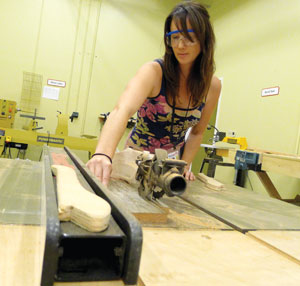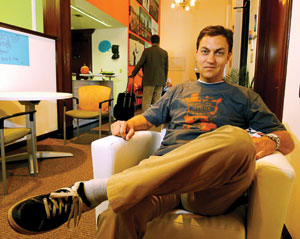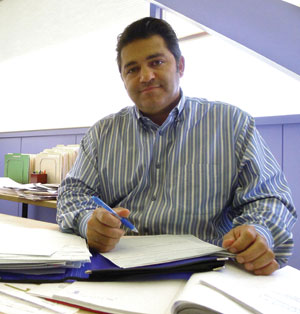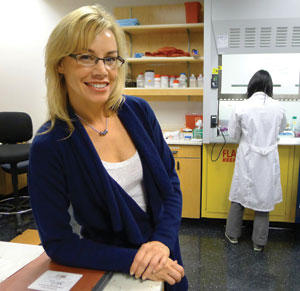Features & Columns
Industrial Re-Evolution

AT A table inside the new San Jose TechShop, a 17,000-square-foot building on the corner of Second and San Carlos streets, a young man perches on a stool at a wooden worktable. Holding a large horse head gingerly in one hand, he stares intently at the left nostril. Very carefully, he carves it out of snowy-white faux fur bonded to plastic, shaving down the smallest edge to find the right shape.
The workshop is filled with identical tables, all made in-house on the shop's 4-by-8-foot ShopBot CNC Wood Router System.
A few tables away, another man sets three iPod docks up on the table. In a room in the back, a young woman peers into the observation window of an Epilog Helix 60-Watt Laser Cutter, supervising as the machine slices wedding invitations to her specifications.
That's the idea behind TechShop. Whatever the vision—a horse head (that was for a production of A Midsummer Night's Dream, by the way), wedding invitations or the prototype for an iPod dock—the studio provides the tools and know-how to help realize it.
In the past, a lack of capital—be it machinery, money or a work space—might have thwarted an aspiring entrepreneur's ability to start a business.
In Silicon Valley, things are starting to change. Advances in technology have made it possible to start up and stay up simply by sharing. The increasing popularity of collaborative consumption—enterprises like ZipCar, the membership-based car-sharing service, or Airbnb, the site that matches vacationers with available homes—has, in recent years, proven the value of resource pooling.
The idea that each worker needs his or her own desk, chair, telephone and filing cabinet may be anachronistic and inefficient in an age of cloud storage and smartphones.
"Two thirds of the day the typical office is empty," says Jeremy Neuner, CEO of the coworking facility NextSpace, which has branches in San Jose, San Francisco, Santa Cruz and Culver City. "People are off at client sites or they are telecommuting or they are in a conference room or whatever."
In the future as Neuner sees it, "the workplace will no longer be a place—it will be a portfolio of places that you will pick and choose from almost on a real time basis based on who you are and what you're doing that day and who you need to work with and even what your mood is, quite frankly."
"Companies are learning that big corporate campuses are expensive to build, they're expensive to maintain, they're expensive to heat and keep cool, " Neuner says. "So they think about downsizing their real estate portfolio."
Now, throughout Silicon Valley, these principles are being applied to the supply side of the economic equation. Call it collective capital. Call it collaborative production. From TechShop to Plug and Play to NextSpace to BioCenter—Silicon Valley is learning to share, and the idea is making everyone richer.
 Jennifer Braun isn't afraid to get her hands dirty, and TechShop is more than happy to ablige. Here, Braun is working on...something. Whatever it is, chances are she'll have all the tools she'll need, and thensome.
Jennifer Braun isn't afraid to get her hands dirty, and TechShop is more than happy to ablige. Here, Braun is working on...something. Whatever it is, chances are she'll have all the tools she'll need, and thensome.
Life Savers
TechShop offers entrepreneurs access to the heavy or specialized machinery that in the past would have been out of reach except to the heavily capitalized. Perhaps more valuable, however, is the access that members gain to TechShop's collected brain trust.
Consider the infant-warming device known as Embrace. Rajan Patel and Naganand Murty were recently back from Nepal when they came into TechShop with an idea.
Twenty million low-weight and premature babies are born every year, a large share of those in areas far removed from an incubator. While students at Stanford's design school, the pair had taken on a challenge to design an alternative that could function in remote areas.
The pair knew that the product's utility would be limited if it required electricity or training to operate. They envisioned something simpler, cheaper and without moving parts, but with the ability to regulate a baby's body temperature when access to an incubator was not an option.
"They sat down and started working, and people were hanging around, and word gets out that they are saving babies' lives, right?" TechShop CEO Mark Hatch recalls. Members began to approach Patel and Murty to offer their expertise.
According to Hatch, the conversations went something like this: "'What do you know about polymer chemistry—more than a polymer chemistry Ph.D. at Lawrence Livermore Labs?'" he chuckles. "'No.' 'What do you know about material construction of the blanket—more than the product vault at IDEO?'"
Hatch explains, "These are people who are just members who come by and help them upgrade their core intellectual property for free. Just do it because it's a good thing to do."
Embrace, the product that resulted, looks like a tiny sleeping bag. Inside is a pouch; a small packet of phase-changing material can be removed, warmed (by dunking it in hot water or using an electric heater) and reinserted where it will keep the interior of the blanket at a toasty 98.6 degrees—the critical temperature for survival. The packet can be rewarmed as necessary, until the child's hypothalamus develops enough to regulate its own body temperature.
They managed to create a highly effective product, but more importantly they were able to do it for a ultimate cost of $25, less than 1 percent the cost of a traditional incubator.
Patel and Murty founded a company and have partnered with General Electric to begin distributing Embrace in India. They estimate the blanket will save 100,000 lives in the next five years.
Hatch reckons that the core intellectual property for the Embrace blanket, like countless other projects at TechShop, got a considerable upgrade simply by virtue of the fact that its inventors worked in a shared space. "You're sitting next to someone who is struggling away trying to figure out what they need to do, and if you have some intellectual property that will help, you know, you could try to negotiate an off-the-property license or you could be a nice human and just give it to them."
The sense of community in collaborative workspaces like TechShop, Hatch says, lends itself to a certain kind of generosity. "In these kinds of environments, what people tend to do is just give it to them. Projects are usually—I wouldn't even say routinely—usually upgraded through working in a space like this."
 NextSpace CEO Jeremy Neuner rewrites all the rules of the traditional office, starting with everyday being business casual.
NextSpace CEO Jeremy Neuner rewrites all the rules of the traditional office, starting with everyday being business casual.
Build Anything
Five years ago, Jim Newton had a binder full of 200 ideas but no equipment with which he could build the prototypes. He envisioned a "Kinko's for Geeks"—a place where the kinds of tools needed to build a model train set or a jetpack would be on hand, as well as mentors to help a person articulate and realize his or her vision.
Newton went to the Maker Fair in San Mateo, the two-day DIY festival where exhibitors show everything from a life-size game of Mousetrap! to a class in advanced water rocketry. He set up a stand, and laid out a sign-up sheet and basic premise: "If I build a membership-based do-it-yourself fabrication studio with a laundry list of tools, will you come?" One percent of attendees, about 250 in total, said they would.
In the half-decade since TechShop opened its first set of doors in Menlo Park, it has been the venue for the creation of a functional jetpack (with a 30-second burn, it is capable of launching a few hundred feet in the air), the world's fastest electric motorcycle (which went 218.673 mph during speed trials at the Bonneville Salt Flats in August), Square (the iPhone credit-card reader recently valued at $1 billion) and a liquid-cooled server cabinet with the capability to reduce energy use by an order of 80 percent compared with the industry standard (potential global savings in energy costs: $800 billion—a year).
"Two hundred and fifty years ago, the tools of innovation and creativity moved out of the guilds and tradesperson's shed and workbench and into corporations," Hatch says. "It was so emotionally and economically jarring we had revolutions."
When machines first automated manufacturing processes, they were so bulky and expensive that they drove all but the richest out of the market. Over the past 30 years, the cost of heavy machinery has come down. At the same time, computer programs have been developed to control the machines.
Now, those two trends have crossed and encountered a third: the move toward consumptive resource sharing. More and more people are realizing that they don't need, want or have the means to own their own power equipment.
The three trends have combined to create the current moment in which a person can walk into TechShop with an idea, take a class, prototype an invention, publicize it and within in 90 days rack up a $1,000,000 in sales. That's the way it worked for Patrick Buckley, the inventor of the Dodo iPad case. The prototype and the first 2,000 units were manufactured at TechShop in 2010.
Hatch has a hypothesis: "If, for the first time in human history, people had access to these incredibly powerful tools and you changed the class of folks who had access to it from a very limited group to tens of millions and you dropped that into a local city for three dollars a day, globally changing technologies would probably erupt," Hatch says. "And they have."
The promise of the 1950s, the golden age of American industrialism, was a chicken in every pot; Mark Hatch wants the promise of next decade to be a TechShop in the parking lot of every Lowe's—around 1,800 locations. It would take the company 20 years to raise the capital to execute that vision on its own, Hatch estimates, 10 with help from a strategic partner like General Electric, Wal-mart or Lowe's.
Commons Sense
When it comes to turning our economy around, TechShop's signature mix of ingenuity and collaboration is just what the doctors ordered. That is, if the doctors in question are Harvard professors Gary Pisano and Willy Shih, authors of the widely circulated 2009 article "Restoring American Competitiveness."
"Centuries ago, 'the commons' referred to the land where animals belonging to people in the community would graze," the professors wrote in a piece published in the Harvard Business Review. "The commons did not belong to any one farmer. All were better for having access to it."
Modern industries have a commons, they say, and those commons are absolutely essential to an industry's capacity for innovation. America's industrial commons—particularly the commons of our high-tech manufacturing industry, based in Silicon Valley—have been devastated by years of outsourcing.
Silicon Valley is the epicenter of the nation's high-tech manufacturing industry: 12.6% of American jobs in the computer and electronics products manufacturing industry are based in the San Jose metropolitan area—that's 15 times the national concentration, according to figures from the Public Policy Institute of California. In recent years, though, manufacturing in the high-tech sector has declined from 51 percent to 29 percent due to job losses between 1992 and 2010 as those jobs have been sent abroad.
Beginning in 2000, America's trade balance in high-tech products began to reverse—we went from a surplus of $27.8 billion in 2000 to a deficit of $43.6 in 2011. Pisano and Shih contend the reversal was in large part caused by outsourcing the manufacturing of high-tech products like, for one example, the component pieces that make the Kindle 2.
More than the job itself is lost in the move: "Once manufacturing is outsourced, process-engineering expertise can't be maintained since it depends on daily interactions with manufacturing," the professors say. The only way to rebuild our industries' razed commons is to start manufacturing and collaborating on projects here. "Lose the commons and you lose the opportunity to be the home of the hot new business of tomorrow."
 Googling Saeed Amidi may not yield any recognizible results, but the search engine itself is the result of Amidi's open-door policy for startups, having housed the tech giant from its inception.
Googling Saeed Amidi may not yield any recognizible results, but the search engine itself is the result of Amidi's open-door policy for startups, having housed the tech giant from its inception.
Fresh Spleens
Picture three puzzled entrepreneurs staring down at an open box—its contents: one frozen spleen. This was the scene a few months ago at the San Jose BioCenter, a facility that applies a resource-sharing model similar to TechShop's, but in life sciences rather than manufacturing.
The entrepreneurs were working to develop an "antibody discovery platform." Antibodies are needed to make an effective drug, but they are usually extracted from B cells. The team in question, a company called Single Cell Technology, was developing a way to extract antibodies from plasma instead. There was only one problem—they were used to fresh meat.
"Typically, if it's a fresh spleen, it is just packed in ice," says Melinda Richter, executive director of the BioCenter. "Then the cells don't have to be unthawed. In this situation, they had to figure out how to unthaw the spleen and still make sure the cells were viable." And they had to do it fast—plasma cells die within 24 hours.
To secure the time of a technician who could provide the kind of support they needed would have meant a week of lost time. Luckily, there was someone with precisely the expertise they required, working in a lab just down the hall. He helped the team write a standard operating procedure that day.
It might not be accurate to call it luck, though—when you bring scientists together, innovation spreads. "In life sciences in particular, intellectual property is much more guarded," Richter says of the collaborative environment at BioCenter, "but what we've found here is that people trade ideas around processes,"
The 40,000-square-foot facility offers everything from centrifuges, balances and water baths all the way up to a cold room, a tissue-culture lab and a million-dollar nuclear magnetic-resonance system. The idea is to give scientists the infrastructure to develop a proof of concept, demonstrating the feasibility of a technology to investors.
"You can throw two guys in a garage with a couple of computers and a little bit of money, and in two years they can turn that into a company they can sell to Microsoft or Google for $200 million—and not that that doesn't have societal value, it does—but it's not curing cancer, it's not solving HIV, it's not curing Hepatitis C," says Richter. "The reason there are not more cures, the reason healthcare is not more effective, is because if a scientist looks at starting a company, even before they turn the lights on it's going to cost them millions of dollars."
BioCenter, Richter says, makes breaking into any of a host of industries based on biology, chemistry or material sciences "as affordable as going to the gym." That is, if your gym charges $500 a month—the cost of membership in the BioCenter's new Concept Lab, which opened in September, designed to help entrepreneurs develop a proof of concept.
Five hundred dollars a month is a comparative bargain when one considers that it takes the typical biotech company eight to 12 years and $2.2 billion before a product makes it to the market. Having access to a central location with the equipment services and co-workers with industry know-how can reduce the upfront costs significantly.
Space Race
The success of TechShop, BioCenter and the businesses both have spawned speaks to the possibilities of collaboration and resource sharing across sectors. It is indicative of a fundamental shift in the way that companies are being created and work is being done.
"If I've got an iPhone and a laptop and an Internet connection," Jeremy Neuner says, "generally speaking, there's nothing I can't do if I'm in a creative, knowledge-based economy."
At the same time that technology is allowing many to work anywhere, a lot of companies are deciding that it will be more cost effective not to host all of those employees in one place.
Neuner's NextSpace provides a physical building with a mailing address, desk space, WiFi, coffee and community. One may be able to do work from anywhere these days, but you still have to do it from somewhere, and if you are a "solopreneur," there is something to be said for doing it around other people.
In some cases, co-working could advance business prospects. "It might just be that I'm a freelancer, I'm a solopreneur, I'm a telecommuter and because I work at NextSpace I meet a few people, and now I know some cool people that I didn't know before," Neuner explains. "Those people start to trade ideas and trade expertise and little bits of knowledge, and you find that the person sitting next to you is exactly the guru that you need to help you with your project or with your work."
It can be something as simple as the app developer sitting next to a graphic designer and enlisting them to design the icon and logo, or two single-employee companies joining forces to become one two-person company.
Or it could be many entrepreneurs joining together. "They all started out as independents or little groups of two who didn't know each other before they came to NextSpace," Neuner says of the eight or nine individuals who would become the team behind AOL's Additions. "They found each other at NextSpace, realized that they had complementary skills, came together into a company, created some cool applications that got on everybody's radar screen, AOL acquired them not even a year ago to be sort of their lead mobile team"
As the workplace is changing, so is the social life that was once built-in. Co-working facilities like NextSpace are filling a newly created void as the changing workplace alters workers' social lives. Co-workers at San Francisco's NextSpace have gone on not just to start businesses but to start a band, the Dodgy Winos, and at both the San Francisco and Santa Cruz offices, chapters of a running group, the NextPacers, have started.
 BioCenter CEO Melinda Richter is offering a scientific smorgasboard of tools and major essentials to aid in science's next big discovery.
BioCenter CEO Melinda Richter is offering a scientific smorgasboard of tools and major essentials to aid in science's next big discovery.
Plug In, Ramp Up
Number 165 University Ave. in Palo Alto is a modest two-story building with a beige stucco exterior. A vegan cafe called Loving Hut and a T-Mobile store occupy the street level retail spaces. It is the upstairs though, where one will find the office space that has flushed the capital markets with billions of dollars in IPOs.
The building was home to Google's first office (around the time the garage was getting too crowded for the company's eight employees). It was the first American office of Logitech after the founders, two Stanford MBAs, moved the company stateside from Switzerland. PayPal was started there too, as was Danger, the company that launched the first smartphone, T-Mobile's Sidekick.
Saeed Amidi was the building's landlord. Watching Google, Logitech and PayPal gave Amidi the idea (and a few early investments gave him the capital) to start Plug and Play Tech Center, a Silicon Valley incubator, in 2006.
"You could say by chance, or by being involved in real estate, we got to meet Google, PayPal, Danger," Amidi says from his office at the company's headquarters in Sunnyvale.
Through Plug and Play, Amidi and his associates have the opportunity to be a little more hands-on in the startup process. Like NextSpace, Plug and Play offers co-working spaces at campuses in Sunnyvale, Palo Alto and Redwood City, but that is only a small part of what they do. The company's larger concern is identifying and fostering promising startups from a fledgling state to a full-fledged one.
It's a mission that Amidi says, is only now possible in the current state of technology. A startup in the tech world, he says, doesn't "need as much money to build their product because they host their product in the cloud. They don't need hardware anymore; they use other platforms like Facebook or iPad or iPhone. They can grow virally on top of these platforms, so they don't need to have a huge team, they can have a very precise team. You don't need as much money."
In this climate, Amidi adds, "You can grow faster with less money, less hardware and, quite frankly, less real estate."
Like TechShop and NextSpace, at Plug and Play the idea of collaboration is the key element in creating world-changing technologies. President Canice Wu cites the example of a Canadian company called Eat Lime.
Eat Lime started at the University of Waterloo. It was identified by the Canadian Trade Commission and came to Plug and Play through the company's "International Bridge" program, a kind of in-sourcing, in which companies are brought to Silicon Valley to see if they can gain a foothold.
"They had some interesting intellectual property around video compression, so they came to Plug and Play and through a lot of our introductions and network," Wu says. "Literally in 30 days, they pivoted from video compression, but leveraged that into video sharing on Twitter."
The company rebranded as TwitVid and ultimately received seed funding from the venture capital firm Draper Fisher Jurvetson along with a handful of angel investors.
"It's an example of what can happen in this community where you have a certain idea but again getting a lot of feedback and validation and a mentor who can say 'uhuh,' there is a huge opportunity in either adjacent space, or in leveraging the technology but in a different form," Wu says. "All of a sudden, they found a very, very lucrative opportunity."
There are close to 300 companies in the three-story building, all at different stages of gestation and among them, Wu says, there is constant collaboration of this kind. "We find that kind of openness very valuable. We're not asking people to share the secret sauce, but just talk about ideas and get a lot of feedback, that's where the business can take off much, much faster."
Access Is Key
"The entire aircraft industry was started because the Wright Brothers had a mill and a lathe in the bike shop," Mark Hatch of TechShop says. "Edison had a mill and a lathe in his shop. You can't build important innovations without access to mills and lathes."
As critical as the mill and lathe, or any tool in the TechShop artillery, any piece of infrastructure provided by NextSpace, any bit of funding secured through Plug and Play is the intangible and often unpredictable collaboration that goes on within their halls. "Go into an empty office space, and the energy just drags you down. You've got to create that excitement you know," Plug and Play President Canice Wu explains. "Here a startup can just plug right into it—it's already there."
The beauty of the new commons emerging in Silicon Valley is not just that aspiring entrepreneurs have, for cheaper and easier than ever before, access to the mills, the lathes, the WiFi, the coffee, the seed funding—it is that the structure that allows more people access to this collected capital is itself becoming an engine to innovation.
The new commons are emerging, and not a moment too soon, since across industries, professors Pisano and Shih say, their importance cannot be understated. As they write, "Our research on the semiconductor, electronics, pharmaceutical, and biotech industries has found that commons are even more important to countries' and companies' prosperity than is generally believed. That's because innovation in one business can spawn whole industries."


